
Gymnastics is a sport that includes physical exercises requiring balance, strength, flexibility, agility, coordination, dedication and endurance. The movements involved in gymnastics contribute to the development of the arms, legs, shoulders, back, chest, and abdominal muscle groups. Gymnastics evolved from exercises used by the ancient Greeks that included skills for mounting and dismounting a horse, and from circus performance skills.

A histogram is an approximate representation of the distribution of numerical data. The term was first introduced by Karl Pearson. To construct a histogram, the first step is to "bin" the range of values—that is, divide the entire range of values into a series of intervals—and then count how many values fall into each interval. The bins are usually specified as consecutive, non-overlapping intervals of a variable. The bins (intervals) must be adjacent and are often of equal size.
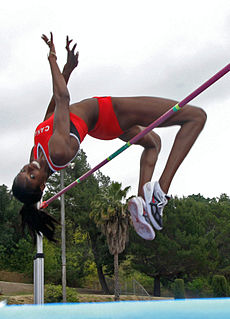
The high jump is a track and field event in which competitors must jump unaided over a horizontal bar placed at measured heights without dislodging it. In its modern, most-practiced format, a bar is placed between two standards with a crash mat for landing. Since ancient times, competitors have introduced increasingly effective techniques to arrive at the current form, and the current universally preferred method is the Fosbury Flop, in which athletes run towards the bar and leap head first with their back to the bar.
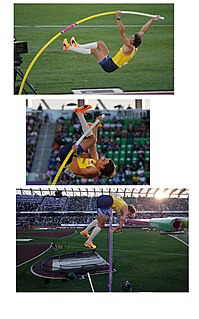
Pole vaulting, also known as pole jumping, is a track and field event in which an athlete uses a long and flexible pole, usually made from fiberglass or carbon fiber, as an aid to jump over a bar. Pole jumping competitions were known to the Mycenaean Greeks, Minoan Greeks and Celts. It has been a full medal event at the Olympic Games since 1896 for men and since 2000 for women.

Track and field is a sport that includes athletic contests based on running, jumping, and throwing skills. The name is derived from where the sport takes place, a running track and a grass field for the throwing and some of the jumping events. Track and field is categorized under the umbrella sport of athletics, which also includes road running, cross country running and racewalking.

Sergey Nazarovych Bubka is a Ukrainian former pole vaulter. He represented the Soviet Union until its dissolution in 1991. Bubka was twice named Athlete of the Year by Track & Field News, and in 2012 was one of 24 athletes inducted as inaugural members of the International Association of Athletics Federations Hall of Fame.
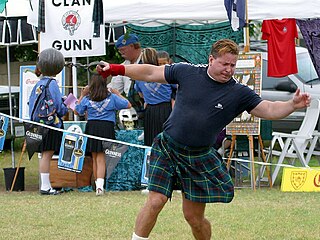
Two sports have events that fall under the name of weight throw one being the track and field event and the other being the Scottish highland games events.
The men's pole vault was one of six jumping events on the athletics at the 1908 Summer Olympics programme in London. The competition was held on Friday, July 24, 1908. 15 pole vaulters from seven nations competed. It is the only one of the 111 events featured in 1908 to not have any competitors from the host nation. NOCs could enter up to 12 athletes. The event was won by Edward Cook and Alfred Carlton Gilbert of the United States, the nation's fourth consecutive victory in the men's pole vault. The tie was permitted, rather than a jump-off being held, due to the length of the competition. Similarly, bronze medals were awarded to all three men who had cleared 3.58 metres for third place. Sweden and Canada thus received their first medals in the pole vault, while the United States had the unusual distinction of winning three medals in an event but not sweeping.
David Volz is a retired American pole vaulter, who finished fifth at the 1992 Summer Olympics in Barcelona. In addition, he won a bronze medal at the 1985 Summer Universiade. With 5.75 meters in 1982, Volz and Jean-Michel Bellot shared the number one spot on the top performers list that year.
The men's pole vault at the 1988 Summer Olympics in Seoul, South Korea had an entry list of 21 competitors from 13 nations, with two qualifying groups before the final (15) took place on Wednesday September 28, 1988. The maximum number of athletes per nation had been set at 3 since the 1930 Olympic Congress.

The Men's Pole Vault was an event at the 1992 Summer Olympics in Barcelona, Spain. There were a total number of 34 participating athletes from 23 nations. The maximum number of athletes per nation had been set at 3 since the 1930 Olympic Congress. The qualification mark was set at 5.60 metres.

The men's pole vault event at the 1984 Summer Olympics in Los Angeles, California had an entry list of 19 competitors from 13 nations, with two qualifying groups before the final (12) took place on Wednesday August 8, 1984. The maximum number of athletes per nation had been set at 3 since the 1930 Olympic Congress. The event was won by Pierre Quinon of France, the nation's first medal in the men's pole vault. France also took one of the two bronze medals after Thierry Vigneron tied with Earl Bell of the United States for third. Mike Tully, also American, earned silver. Bell and Tully continued the American streak of podium appearances in the event every time the United States competed.

The men's pole vault event at the 1980 Summer Olympics in Moscow, Soviet Union had an entry list of 19 competitors from 10 nations. The maximum number of athletes per nation had been set at 3 since the 1930 Olympic Congress. The final was held on Wednesday July 30, 1980. The top twelve and ties and all those clearing 5.40 metres advanced to the final. The event was won by Władysław Kozakiewicz of Poland, the nation's second consecutive victory in the men's pole vault. His countryman Tadeusz Ślusarski, who had won the event four years earlier, became the fifth man to earn two medals in the event when he finished in a tie for silver. The other silver went to Konstantin Volkov and was the Soviet Union's first pole vault medal.

Renaud Lavillenie is a French pole vaulter. Lavillenie won the gold medal at the 2012 Olympics in London and the silver medal at the 2016 Olympics in Rio. In addition to his Olympic success, he has won three World Indoor Championships gold medals (record), three European Championships gold medals and four European Indoor Championships gold medals. He has also won one silver medal and four bronze medals at the World Championships. As of 25 August 2016, he holds the French national records for the highest pole vault clearance both outdoors and indoors. The 6.16 was the absolute world record for the pole vault for over six years, 2014–2020. He was the pole vault overall winner of the IAAF Diamond League in seven consecutive years, from 2010 to 2016.
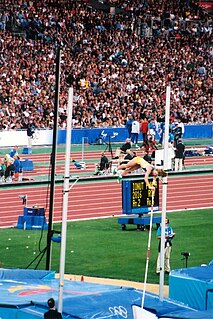
The men's pole vault event at the 2000 Summer Olympics as part of the athletics program was held at the Olympic Stadium on Wednesday, 27 September and Friday, 29 September. Thirty-six athletes from 22 nations competed. The maximum number of athletes per nation had been set at 3 since the 1930 Olympic Congress. The event was won by Nick Hysong of the United States, the nation's first victory in the event since its 16-Games streak ended. The American team also took silver, as Lawrence Johnson finished second. Maksim Tarasov became the seventh man to win multiple pole vault medals, and the second to do so under two different flags, adding a bronze to his 1992 gold.
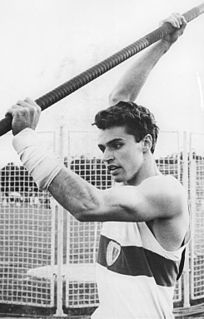
The men's pole vault field event at the 1972 Olympic Games took place on September 1 & 2. Twenty-one athletes from 12 nations competed. The maximum number of athletes per nation had been set at 3 since the 1930 Olympic Congress. The event was won by Wolfgang Nordwig of East Germany, the first non-American to win the event. Nordwig and silver medalist Bob Seagren were the third and fourth men to win multiple medals in the event.

The men's pole vault competition featured in the athletics programme at the 1976 Summer Olympics and was held at the Olympic Stadium in Montréal on 24 and 26 July. Twenty-seven athletes from 13 nations competed. The maximum number of athletes per nation had been set at 3 since the 1930 Olympic Congress.

Alysha Eveline Newman is a Canadian track and field athlete who specializes in the pole vault. She competed at the 2016 and 2020 Olympic Games. Newman was the 2018 Commonwealth Games champion in the women's pole vault, where she set a new Games record of 4.75 metres (15.6 ft).
Deakin Volz is an American track and field athlete, known for pole vault, though he has also had success in the high jump. He is the 2016 World U20 (Junior) champion, where he jumped a personal best of 5.65 m in Bydgoszcz, Poland. Deakin comes from a family line of vaulters as his brothers Drake and Drew are also pole vaulters. They are all coached by their father, 1992 Olympian Dave Volz, made famous for inventing his namesake technique of replacing the crossbar while still in the air. The now banned technique, named after the elder Volz, embeds the family name in the modern rulebook.
The men's pole vault at the 2022 World Athletics Championships was held at the Hayward Field in Eugene on 22 and 24 July 2022.














